Samsung washing machine spins poorly

Is your washer spinning at all?
The troubleshooting here is relevant if your washer is spinning (or at least it started to spin) but there's some issue with how it spins, such as it stopping mid-cycle. If your washer never even starts to spin at all, see our washer does not spin guide instead, as it has less troubleshooting steps to perform and could save you some time.
Checkpoint
- A
- B
- C
- D
- E
- F
Check your washing machine load size, and the cycle you are using
Under certain conditions, your laundry will not evenly distribute within the drum, which can cause imbalance as too much weight collects on one side.
- Small loads: Small loads tend to collect together to one side, leaving the other side empty, which creates a weight imbalance. Add more to the load to balance it, or reduce the spin speed.
- Large items: When washing bed sheets, blankets, or other large items that absorb a lot of water, they can become tangled and then cause unbalanced loads. In this case, manually redistribute the load to even out the weight distribution. Reducing the spin speed can also be helpful. (Do not wash floor mats, pillows, or dog houses.)
Make sure the washing machine is level
Level the pedestal first.
When using a pedestal or riser, it should be leveled first before the washer is installed on top.
Before you begin the process of leveling, make sure to have one inch of separation between the washer and dryer and from any wall.
You'll also want to make sure the floor is stable and free from damage. A slippery floor can disturb the balance of the washing machine.
Excessive force may damage the leveling feet.
The washer should have a solid and firm connection at all four corners. If one corner wobbles, first shorten the legs of all the other corners. If they're already as short as they can be, then the wobbly corner's leg should be lengthened.

Use a flat blade screwdriver to loosen the locking nut of the legs you'll be adjusting.

How many legs?
All front load washers have four adjustable legs. Some top load washers do too, while other top load models only have two or three adjustable legs, in which case the remaining legs are not adjustable.
Turn the adjustable legs clockwise to raise that corner of the washer, and counterclockwise to lower that corner of the washer.
Continue to make adjustments and repeat the previous steps until the washer is level. As you're making adjustments, keep in mind that the shorter you can keep the legs, the more stable the washer will be. Make sure that all feet are making contact with the floor.
Just like before, use a flat blade screwdriver to tighten the locking nut up against the washer.

Run the washer with a small load of laundry to determine that it does not shake or vibrate when the washer spins. If it does, continue to adjust the legs until it does not.
Clean the washing machine pump filter (front load only)
Only front load models have pump filters.
If your model is not a front loader or does not have a pump filter, skip to the next checkpoint.
What does this have to do with a spin issue?
Before the washer spins, it tries to drain. If it's unable to drain, it never moves to the spin step. Since the pump filter should be cleaned routinely (about once a month or 40 washes, whichever is more frequent), we'll check this first.
If you've recently cleaned your pump filter within the last month and within the last 40 washes, you can skip to the next checkpoint. Otherwise you should take the time to clean it now.
To begin, open the pump filter door panel by pressing on the cover.
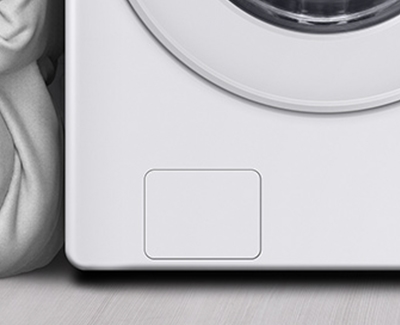
Locate the rubber drain hose and prepare to drain the water. You will need a towel and a container large enough for the amount of water in the washer, like an oil drain pan.
Remove the cap from the drain hose by holding the hose and twisting the cap. The cap can be tough to remove because it forms an airtight seal, so make sure to use a little elbow grease. Once the cap is removed, drain the water.
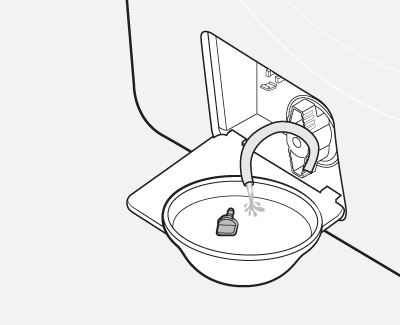
Once all the water is drained, remove the washer pump filter by twisting it counter-clockwise.
On some Samsung washers, the washer pump filter (A) is similar to the cap on a medicine bottle. Push in and twist it to remove the cap.
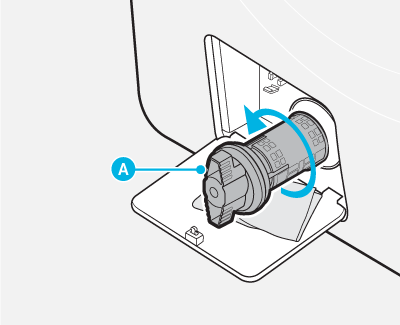
Using a small toothbrush or other similar soft bristle brush, wash any dirt or other materials from the pump filter. Inspect the drain pump impeller (located inside the pump filter housing) to make sure it is clean.
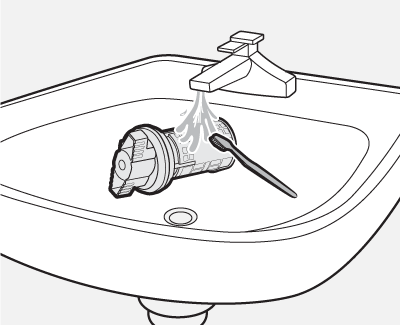
Make sure the washing machine's drain hose is installed correctly
What if my washer's been installed for a long time and hasn't had an issue?
Issues caused by an incorrectly installed drain hose are not always experienced immediately after installation; they can be something that build up over time before reaching a point severe enough to cause drain or spin issues. The drain hose should still be checked even if installation was not recent.
The drain hose must be inserted into the drain pipe at least 6 inches, and no more than 8 inches. Use the hose guide included with the washer to help, and then once the drain hose is in place, secure it with a zip tie so it will not slip down farther.
If the drain hose is more than 8 inches deep, it creates a siphoning effect which will cause issues with the washer. If the drain hose is inserted less than 6 inches, it may fall out which will cause water to spill all over the floor.
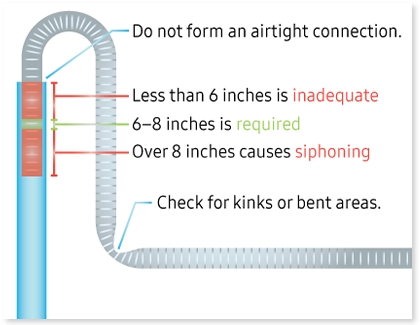
An airtight connection creates a vacuum or suction effect that also causes siphoning.
Most homes will already have the correct measurements, but it is good to check anyway to be sure. The drain hose should be positioned at least 18 inches high and no more than 96 inches high. You should not use a drain hose extension kit.
These requirements are different if a sink is being used. The drain hose should be positioned at least 24 inches high for sinks and no higher than 35 inches.
The hose should run smoothly from the washer to the home's drainage system. Anywhere that it is bent or pinched can cause leaks or draining issues.
If the drain hose is damaged, request service.
Do not remove the drain hose screw
Do not remove the screw on the back of the washer that holds the drain hose against the washer. If the screw has been removed, screw it and the holder back in with any screw that fits. If the holder is missing, service is required.
It may be tempting to unscrew this clamp holding the drain hose to the back of the washer, especially if the drain hose doesn't quite reach as far as you want it to. However, removing this may cause the washer to drain automatically and give an LC or 4C error code.

Run calibration mode on your washing machine
Double check that there are no items left in the drum, such as socks.
On some models, you do this while the washer is already on. On other models, you start with the washer off, hold the two buttons, and then touch Power to turn on the washer while holding the buttons.
Either way, if you're successful, Cb appears on the display and you can let go.
Temp. and Delay End is the most common button combination, but if that doesn't work or you don't have those buttons, check your user manual for instructions specific to your model. If your user manual does not cover Calibration Mode, then your model doesn't have it.
The tub will then rotate back and forth (the duration varies between 1 and 3 minutes), display En, End, or 0, and then turn off. The washer is now calibrated.
Request Service
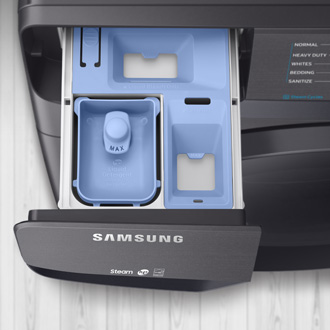

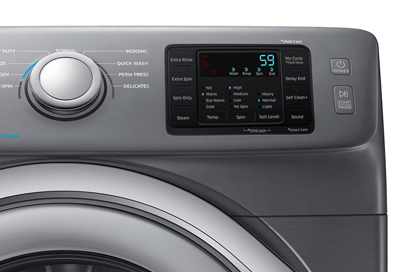
Thank you for your feedback! Your comment has been submitted.
Contact Samsung Support


- Home Home
- Support Support
- troubleshoot troubleshoot
- Samsung washing machine spins poorly Samsung washing machine spins poorly

